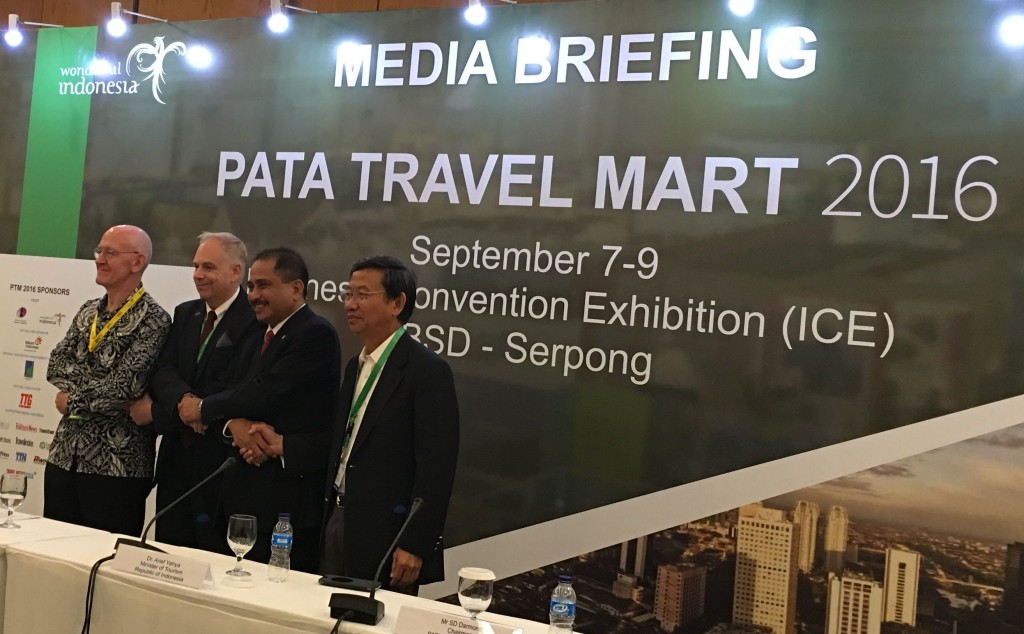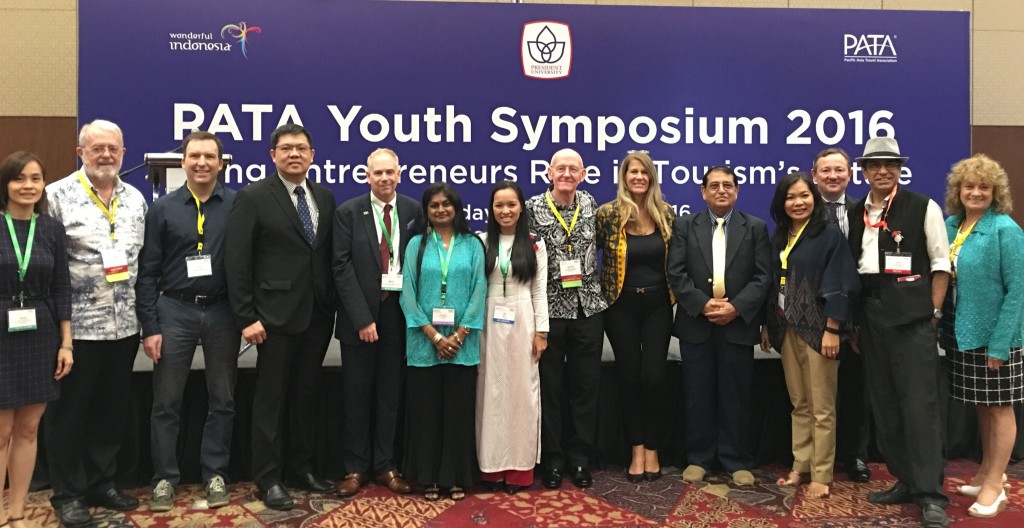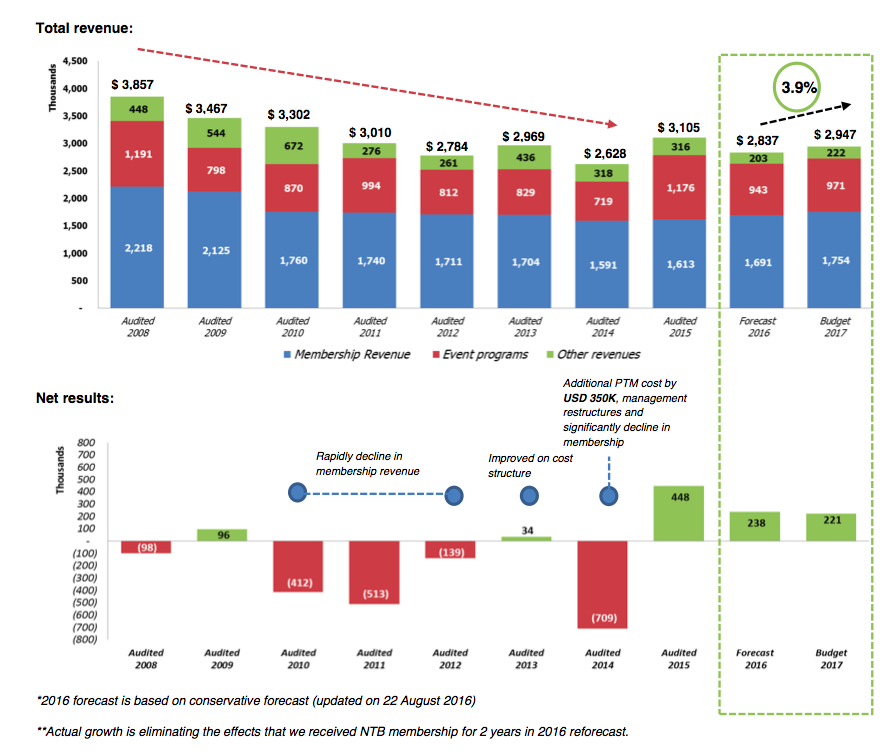12 Sep 2016
PATA Mart 2016 proves that Big is Not Necessarily Beautiful
Jakarta – PATA’s steady turnound remained on track at the 39th PATA Travel Mart between Sept 7-9, the fifth to be held in Indonesia. While the turnout of roughly 1,000 delegates for the PTM and its associate events still paled in comparison to the heydays of the 1990s, the Mart is now well set as the top small & medium sized travel show in which quality trumps quantity and niche-markets trump mass-markets. Along with the high-calibre content of its accompanying forums, the PTM is proving that Big is Not Necessarily Beautiful in an intensely competitive trade show environment.
With the PATA brand as the adhesive, the fraternity of veterans and life-members (average age 70-80) mixed with the youth (average age 20-25). Business leaders mixed with bloggers. Techno-babblers mixed with environmentalists. Hoteliers schmoozed with OTAs. This year’s PTM saw the first-time participation by Zimbabwe and Palestine. Both destinations are facing geopolitical and economic challenges but were at PTM to tap the outbound potential of the PATA region and defy what they see as a common perception problem created by negative reports in the global TV networks. Both booths were chock-full busy as curious and somewhat intrigued buyers from the Asia-Pacific and beyond queued up to ask questions and explore opportunities for sending visitors to destinations never before seen at a PATA Mart.
Arguably, no other mid-sized travel mart can muster such an international crowd. This year, PATA’s primary revenue generating event and the second largest contributor to PATA coffers after membership was attended by 258 buyer delegates, led by 38 from China, 31 from Indonesia, 15 from India and 11 from Singapore. Russian and Korean buyers totalled 10 each. The directory listed 82 delegates as first-time buyers, from countries as diverse as Kazakhstan and Croatia. The directory listed 272 seller organizations and 683 delegates. Indonesians obviously led the line-up with 85, followed by India with 25, and Malaysia and China with 15 each. None were cited as first-time sellers.
Financial reports presented to the board meeting indicated that the PTM 2016 is projecting revenues of US$646,179 and a bottom-line surplus of US$535,679. The Indonesian Tourism Ministry agreed to host the venue costs of US$140,000 and got 450 sq m of booth space. Total revenue 2016 projections for PATA as a whole are pegged at US$2.8 million, with a net surplus of US$238,000, by conservative estimates. The bottom-line could go up if all outstanding membership dues are collected partially or fully. PATA has set a full year membership revenue target of US$1.7 million. As of August, US$324,000 was still in arrears from 145 members, including 22 NTOs and 11 airlines.
The trade show itself ended with the roster of buyers and sellers complaining or complimenting the event, as they always do. Many sellers were pleased to see so many first-time buyers but will now await actual business generation. The show’s TTG dailies reported trends such as the return of the Russians to the Asia-Pacific thanks to the strengthening of the ruble, and European tour operators seeking new beach-holiday markets in the Asia-Pacific to offset the security-related decline to the traditional summer break destinations of Egypt, Tunisia and Turkey. Both are good news for the PATA region.

At the Indonesian media briefing – PATA Chairman Andrew Jones, CEO Mario Hardy, Tourism Minister Arief Yahya and PATA Indonesia chapter chairman Setyono Djuandi Darmono.
Indonesia, too, got a chance to showcase its brand new convention centre and new tourism policy. The country has just announced its new visa-free policy for 169 countries as part of its drive to generate 12 million visitors by 2016 and 20 million by 2019. At his press conference, Indonesian Tourism Minister Arief Yahya listed the 10 destinations that will be promoted nationwide as part of a cluster policy. One especially prominent exhibitor was Aceh, which was hit by the Dec 2004 tsunami, one of the Asia-Pacific’s worst natural disasters, and is now positioning itself as the country’s leading halal cultural destination.
The Mart venue, the Indonesian Convention Centre (ICE), is the centerpiece of an entirely new city on the outskirts of Jakarta, an urban planning model now widespread in Asia. Designed to decongest the main city, these secondary cities come complete with gated homes for the middle-upper class, malls, working areas, hotels and convention centres. They are all linked by a massive network of roads and highways. For coach and car drivers, the ICE and many other hotels in the new city are still uncharted territory. Many delegates found this out the hard way. Some airport to hotel transfers took three to five hours because coach-drivers did not know the way, and were not equipped with Google map enabled phones.
Once the event got going, PATA’s primary strength manifested itself. Its melting-pot diversity of sectoral, regional, geographical interests was clearly reflected in the quality of the discussions.
For the first time, the Professional Travel Bloggers Association had a booth at PATA, providing participants with a chance to better understand how bloggers operate. The opening day saw the bloggers making stimulating presentations about their work, leading to a rigorous debate with both hard-core journalists (namely, this editor) and travel agents about whether bloggers are infringing on their turf. As the discussion evolved, however, it became apparent that bloggers are just another component of the sharing economy. They have disrupted traditional channels of communications and business. Some see them as threats, others see opportunities.
The Youth Symposium saw spirited discussions among the students on entrepreneurship and the UN Sustainable Development Goals, also for the first time. This year’s Symposium was hosted in cooperation with President University, whose owner/founder Setyono Djuandi Darmono, also heads the PATA Indonesia chapter. PATA CEO Mario Hardy is making a youth focus a priority objective. “The future of the Association lies in its youth,” he said. “It is important that we engage them at all levels.” He said that as there are many aspects in SDGs that directly affect the youth including poverty, quality education, gender equality and the reduction of inequality, PATA “will support these goals by developing a blueprint for a programme of activities throughout 2017 that focus upon young tourism professionals in the Asia Pacific region.”

The youth syposium under way

The line-up of speakers, moderators and PATA executives
Another one of the UN Sustainable Development Goals that Mr. Hardy is incorporating into his agenda is inclusivity and accessibility. The PATA website is being rejigged to make it more accessible to People with Disabilities, be they visually or hearing impaired. It’s not easy, but Mr. Hardy is keen that this should be done.
About to start the last of his three-year tenure, Mr. Hardy has won widespread respect for infusing integrity, transparency and focus into the Association. Following in the footsteps of his counterpart at the UN World Tourism Organisation Mr. Taleb Rifai, he has stabilised the internal operations, put substance ahead of style and devoted more time to listen and act than talk. The board will decide on his extension next year, but it is a done deal, should Mr. Hardy opt to stay on.

Total transparency in the New PATA. 10-year financial performance at a glance.
When he took over in 2014, Mr. Hardy faced the unenviable task of reviving the fortunes of an association still floundering in rough seas. The operating environment was volatile. PATA’s decision-makers were slow to adjust, adapt and respond. Members were rigorously reviewing the bang for their buck, and still are. This year alone, 85 members have jumped ship, losing PATA US$72,000 in dues. Former PATA chairman Kevin Murphy reported that hotel membership is now 11% of the total. In PATA’s heydays, it was as high as 50%. A number of airlines are also known to be reviewing their membership.
On the other hand, new members such as Slovenia, Montenegro, Macedonia, Serbia, the Abu Dhabi Tourism & Culture Authority and Ras Al Khaimah Tourism Development Authority have signed up and are keen to participate in activities and host events. Zimbabwe’s presence and a recent agreement with the African Travel Association will open up new links between the two largest continents of the developing world. The Iranians have indicated they are keen to join. Just after the PTM ended, the Maldives signed up to start a new chapter.

The Zimbabwe Tourism Authority had pride of place at the NTO meeting. Chief Executive Karikoga Kaseke (right) and Head of the China, Asia, Pacific unit Stanley Banda (left)
While the trade show component remains a tough-sell, PATA is expanding its status as a massive idea bank. The over-arching theme “Building the Business” provides a one-stop, year-round platform for PATA members and event participants to tap a plethora of innovations, ideas and insights. ITB Asia may now be the “biggest” regional travel trade show, but it is twice as expensive as PTM. Within a broader context of access to members of one common fraternity sharing ideas, research and trends, the PTM offers far more value for money.
More positive changes are coming. The entire membership is being restructured, with an overhaul set to be announced in 2017. The former 46 categories of membership have been regrouped to 6 with 22 sub categories based on the business of each member and the key benefits and fee. As an adjunct move, a more focussed Customer Relationship Management system is expected to be in place by early 2017.
Additional disruption includes restructuring the committees and councils and enhancing the networking opportunities offered by the chapters. The committees and councils have become fossilised silos and exercises in duplication. There is little of value that can be discussed in mere 90-minute meetings once every six months that is not being done extensively elsewhere. Chapters, too, are punching below their weight.
More important issues await. PATA has yet to adjust its programme content to include more serious big-picture challenges. As the Tourism Authority of Thailand pointed out during the NTOs meeting, competition is no longer important. Generating volume has become a double-edged sword. The quantitative “bigness” of tourism has simply replaced one set of issues with another. Cooperation is now more vital to address problems without passports such as geopolitical and economic turbulence, natural disasters, crime, safety and security, garbage generation, food and water wastage, migrant labour, working conditions, and more. None of these are on the PATA radar screen at the moment.
Mr. Hardy has steadied the financial ship and is working on the components of Building the Business. He now has to ensure that PATA and Asia-Pacific tourism are not just influenced by change but are influencing change. To save the ship from sinking is one thing, to make it serve the business purpose for which it was built is quite another.
(More reports on PTM 2016 coming up).

Ms Azizah Aziz of Tourism Malaysia (second left), Daniela Wagner of PATA Europe and the ladies of Tourism Malaysia.

PATA veterans and stalwarts Wong Soon-Hwa of Blacklane; Tunku Iskandar of Melewar Group Berhad; J.P. Sho of TravelPress Korea; Pilar Laguana of the Guam Visitors Bureau and Alwin Zecha of Pacific Leisure Group.
